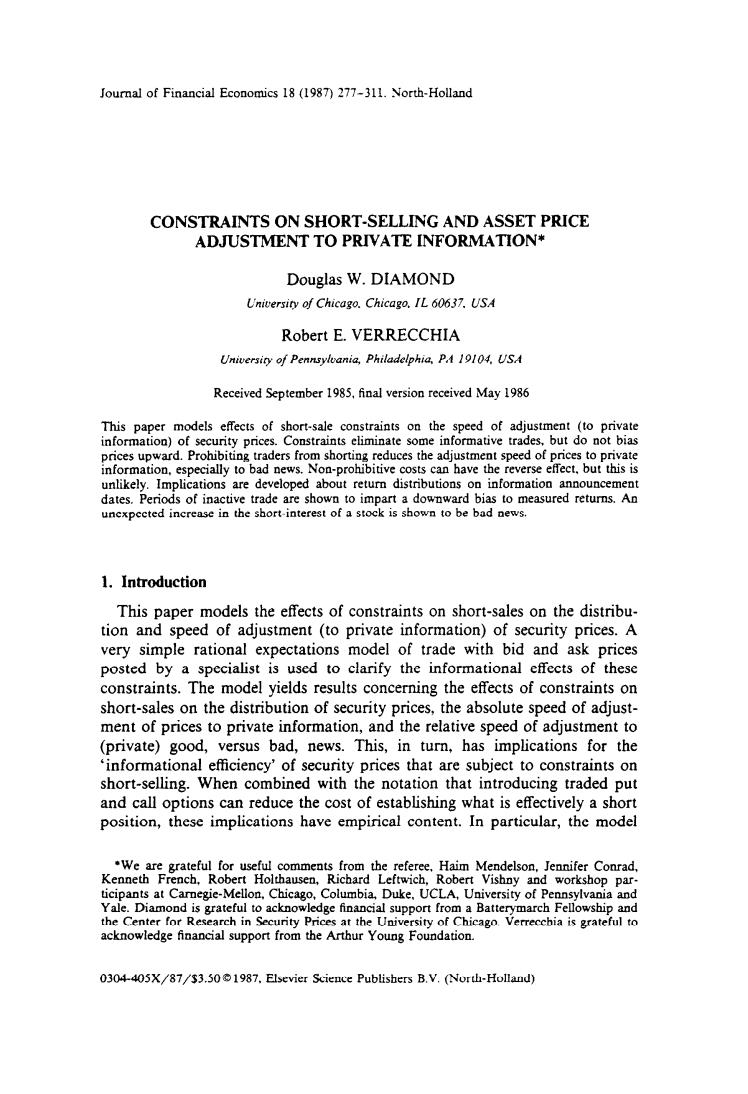正在加载图片...

Journal of Financial Economics 18(1987)277-311.North-Holland CONSTRAINTS ON SHORT-SELLING AND ASSET PRICE ADJUSTMENT TO PRIVATE INFORMATION* Douglas W.DIAMOND University of Chicago.Chicago.IL 60637.USA Robert E.VERRECCHIA University of Pennsylvania,Philadelphia,PA 19104.USA Received September 1985,final version received May 1986 This paper models effects of short-sale constraints on the speed of adjustment (to private information)of security prices.Constraints eliminate some informative trades,but do not bias prices upward.Prohibiting traders from shorting reduces the adjustment speed of prices to private information,especially to bad news.Non-prohibitive costs can have the reverse effect,but this is unlikely.Implications are developed about return distributions on information announcement dates.Periods of inactive trade are shown to impart a downward bias to measured returns.An unexpected increase in the short-interest of a stock is shown to be bad news. 1.Introduction This paper models the effects of constraints on short-sales on the distribu- tion and speed of adjustment (to private information)of security prices.A very simple rational expectations model of trade with bid and ask prices posted by a specialist is used to clarify the informational effects of these constraints.The model yields results concerning the effects of constraints on short-sales on the distribution of security prices,the absolute speed of adjust- ment of prices to private information,and the relative speed of adjustment to (private)good,versus bad,news.This,in turn,has implications for the 'informational efficiency'of security prices that are subject to constraints on short-selling.When combined with the notation that introducing traded put and call options can reduce the cost of establishing what is effectively a short position,these implications have empirical content.In particular,the model .We are grateful for useful comments from the referee.Haim Mendelson,Jennifer Conrad. Kenneth French,Robert Holthausen,Richard Leftwich,Robert Vishny and workshop par- ticipants at Carnegie-Mellon.Chicago,Columbia,Duke.UCLA,University of Pennsylvania and Yale.Diamond is grateful to acknowledge financial support from a Batterymarch Fellowship and the Center for Research in Security Prices at the University of Chicago.Verrecchia is grateful to acknowledge financial support from the Arthur Young Foundation. 0304-405X/87/$3.501987,Elsevier Science Publishers B.V.(North-Holland)Journal of Financial Economics 18 (1987) 277-311. North-Holland CONSTRAINTS ON SHORT-SELLING AND ASSET PRICE ADJUSTMENT TO PRIVATE INFORMATION* Douglas W. DIAMOND Universiry of Chicago, Chicago, IL 60637, USA Robert E. VERRECCHIA Unlversir) o/Pennsylvania, Philadelphia, PA 19104, USA Received September 1985. final version received May 1986 This paper models effects of short-sale constraints on the speed of adjustment (to private information) of security prices. Constraints eliminate some informative trades, but do not bias prices upward. Prohibiting traders from shorting reduces the adjustment speed of prices to private information, especially to bad news. Non-prohibitive costs can have the reverse effect, but this is unlikely. Implications are developed about return distributions on information announcement dates. Periods of inactive trade are shown to impart a downward bias to measured returns. An unexpected increase in the short-interest of a stock is shown to be bad news. 1. Introduction This paper models the effects of constraints on short-sales on the distribution and speed of adjustment (to private information) of security prices. A very simple rational expectations model of trade with bid and ask prices posted by a specialist is used to clarify the informational effects of these constraints. The model yields results concerning the effects of constraints on short-sales on the distribution of security prices, the absolute speed of adjustment of prices to private information, and the relative speed of adjustment to (private) good, versus bad, news. This, in turn, has implications for the ‘informational efficiency’ of security prices that are subject to constraints on short-selling. When combined with the notation that introducing traded put and call options can reduce the cost of establishing what is effectively a short position, these implications have empirical content. In particular, the model ‘We are grateful for useful comments from the referee, Haim Mendelson. Jennifer Conrad, Kenneth French, Robert Holthausen, Richard Leftwich, Robert Vishny and workshop participants at Carnegie-Mellon, Chicago, Columbia, Duke, UCLA, University of Pennsylvania and Yale. Diamond is grateful to acknowledge financial support from a Batterymarch Fellowship and the Center for Research in Security Prices at the University of Chicago. Verrecchia is grateful to acknowledge financial support from the Arthur Young Foundation. 0304-405X/87/$3.500 1987, Elsevier Science Publishers B.V. (North-Holland)